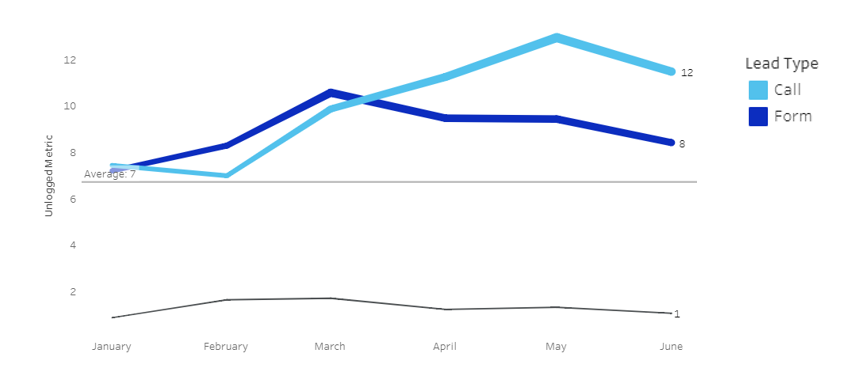
As inventory shortages continue, I’ve increasingly heard from dealerships who are worried about sales process breakdowns and negative customer experiences. To get a tangible sense of the problem, our data science team looked into the average unlogged sales leads (i.e. leads that didn’t get logged to the CRM) of dealership accounts month-over-month.
No surprise: You know your business. Unlogged leads are up dramatically since January.
Average Number of Unlogged Leads by Account

Phone calls, a lead source that relies on manual data entry from salespeople into the CRM, are more affected than forms. May was the worst month of the year with an unlogged rate of 25.8%, but June wasn’t far behind with an unlogged rate at 25.4%. That means more than 1 in 4 sales leads coming through phones aren’t being logged to the CRM.
As a sales manager, I totally see why: Your sales teams are doing the most important work they can be doing right now. They have a high lead volume and they are quickly assessing and seeking out the lowest hanging fruit—the buyer who is going to pay the most money and close the fastest. And it’s natural that a manual step like logging phone leads in the CRM may get missed.
However as a business leader, I should reframe my statement: Your sales teams are doing the most important work a human can be doing to make sales today. But without supporting technology and a long-term plan, it’s definitely not the best work for customer loyalty, lifetime value, or a positive experience with the dealership.
If 25% of your leads aren’t even making it into your CRM, imagine how many more are getting absolutely no follow up. That number is startlingly high, I’m sure. There are a couple of options to solve the two key problems I see in this situation:
Problem #1: Leads not getting logged to the CRM
The classic solution to this is more education and more nagging. Make sure that your team knows how to use the CRM and then drive for perfection. The challenge I have with that is that I can’t measure and report on perfection, so I end up nagging a lot more than I’d like. You have a guy who wants price and availability on that last red Silverado and I see you wrote his name and number on a Post-It? I’m nagging about the CRM. Marketing is claiming a lot more leads than what reporting is showing? I’m nagging about the CRM.
The alternative solution is to use technology. Foureyes has Safety Net, a lead tracking software, to automatically screen phone calls, forms, and chats, identify the sales-qualified leads, and look for them in the CRM. If any leads are missing from the CRM, they get added automatically with relevant notes. And you get a weekly report to track how many leads were added so you have better visibility and security—with no nagging.
Problem #2: Leads not receiving effective follow up
The classic solution to this is to give the leads to marketing for them to handle follow up. The challenge I have with that is I’m effectively taking someone who is lower in the sales funnel and moving them back up. When I know a guy is interested in a red Silverado, a marketing email highlighting the incentives on sedans doesn’t feel particularly effective.
The alternative solution is to use technology. Foureyes has Prospect Engagement, a lead follow-up software, to automatically email prospects with updates about the specific inventory they are interested in. That guy who missed out on the last red Silverado? Foureyes will email him when you get a new one back in stock, or suggest vehicles similar to the searches he’s made on your website (trucks under $50k and always red). The technology is triggered by website or lead activity, meaning it will mirror each user’s engagement, staying with them as long as they are opening and clicking emails and stopping when they’re not.
If you’re not convinced that technology is the way to go, I would love for you to be open to being convinced. Let’s get you on a free 60 day trial of Prospect Engagement. No strings or auto-renewal. All the features, running on all your prospects, aligned to your sales process and CRM structures, for free. And you get full access to the data to see real-time results. It’s an easy way to put infrastructure around your team for better short- and long-term outcomes.
